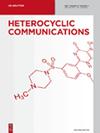Synthesis and optical characterization of bipod carbazole derivatives
IF 1.5
3区 化学
Q3 CHEMISTRY, ORGANIC
引用次数: 3
Abstract
Abstract In this study, some new biscarbazole derivatives were synthesized for the purpose of being used in OLED technologies and related areas. The following compounds: {1,2-bis(2-(3,6-diphenyl-9H-carbazole-9-yl) ethoxy)ethane (C-1), bis[2-(2-(3,6- diphenyl-9H-carbazole-9-yl) ethoxy)etyl]ether (C-2), bis[2-(2-(3,6-di(naphthalene-1-yl)-9H-carbazol-9-yl)ethoxy)etyl]ether (C-3) and bis [2-(2-(3,6-di(naphthalene-2-yl)-9H-carbazol-9-yl)ethoxy) ethyl]ether (C-4) were synthesized by Suzuki-Miyaura Cross Coupling reactions. The structural properties of the synthesized compounds were characterized by FT-IR, 1H-NMR, 13C-NMR, and LC-MS. The maximum product yields of 81.6% were obtained for C-4 biscarbazole derivatives. The optical properties were studied using UV-visible and temperature/excitation power density dependent photoluminescence (PL) techniques. The emissions were observed at green and yellow-red color spectral bands. By applying Gaussian fitting to the measured spectra, the superposition of the broad peaks was deconvoluted into two peaks. The origin of emissions was attributed to π- π* transition in aromatic compounds caused by intramolecular charge transfer from host carbazole to these compounds.两足类咔唑衍生物的合成及光学表征
摘要本研究合成了一些新的双咔唑衍生物,用于OLED技术及相关领域。采用Suzuki-Miyaura交叉偶联反应合成了{1,2-二(2-(3,6-二苯基- 9h -咔唑-9-基)乙氧基)乙烷(C-1)、双[2-(2-(3,6-二(萘-1-基)- 9h -咔唑-9-基)乙氧基)乙基]醚(C-3)和双[2-(2-(3,6-二(萘-2-基)- 9h -咔唑-9-基)乙氧基)乙基]醚(C-4)。通过FT-IR、1H-NMR、13C-NMR和LC-MS对合成的化合物进行了结构表征。C-4双咔唑衍生物的收率最高可达81.6%。利用紫外可见和依赖于温度/激发功率密度的光致发光(PL)技术研究了其光学性质。在绿色和黄红色光谱波段观测到辐射。通过对实测光谱进行高斯拟合,将宽频峰的叠加解卷积为两个峰。发射的起源归因于芳香化合物中的π- π*跃迁,这是由分子内电荷从宿主咔唑转移到这些化合物引起的。
本文章由计算机程序翻译,如有差异,请以英文原文为准。
求助全文
约1分钟内获得全文
求助全文
来源期刊

Heterocyclic Communications
化学-有机化学
CiteScore
3.80
自引率
4.30%
发文量
13
审稿时长
1.4 months
期刊介绍:
Heterocyclic Communications (HC) is a bimonthly, peer-reviewed journal publishing preliminary communications, research articles, and reviews on significant developments in all phases of heterocyclic chemistry, including general synthesis, natural products, computational analysis, considerable biological activity and inorganic ring systems. Clear presentation of experimental and computational data is strongly emphasized. Heterocyclic chemistry is a rapidly growing field. By some estimates original research papers in heterocyclic chemistry have increased to more than 60% of the current organic chemistry literature published. This explosive growth is even greater when considering heterocyclic research published in materials science, physical, biophysical, analytical, bioorganic, pharmaceutical, medicinal and natural products journals. There is a need, therefore, for a journal dedicated explicitly to heterocyclic chemistry and the properties of heterocyclic compounds.
 求助内容:
求助内容: 应助结果提醒方式:
应助结果提醒方式:


